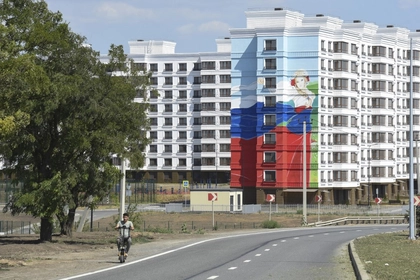A video showing a Ukrainian FPV drone, reportedly equipped for the first time with an AK-74 assault rifle, firing at Russian positions in the Donetsk region has been circulating on social media.
The footage was released by the “Wild Hornets” unit, a group of volunteers that manufactures FPV attack kamikaze drones for the Armed Forces of Ukraine (AFU) on a volunteer basis.
JOIN US ON TELEGRAM
Follow our coverage of the war on the @Kyivpost_official.
“Our military continues to develop the Hornet Queen [drone] equipped with automatic weapons. This time, the first combat deployment was carried out—targeting a position with Russian forces,” the unit stated in an accompanying message to the video.
“This test indicated the direction this project should move forward toward.”
While Kyiv Post could not independently verify the time and location of the video, it shows a small-arms weapon, likely an AK-74 assault rifle, mounted and controlled on a multi-action FPV drone.
“This is one of the initial steps in creating systems capable of destroying targets from the air. The technology has potential, but several factors affecting the effectiveness of such weapons need to be addressed,” a Ukrainian aerial scout told Kyiv Post on condition of anonymity.
“The main challenges include ensuring accurate targeting, which requires additional aiming equipment, as well as dealing with limited ammunition and ensuring quick reloading,” he added.

Ukrainian Naivety is Both Good and Bad
According to the servicemember, inexpensive components for disposable FPV kamikaze drones and bomber drones—capable of delivering significant firepower—have proven to be much more effective.
“But shortly, this technology could develop to the point where drones can fly into trenches and storm tree lines,” the aerial scout said.
He also said that where ground-based rifle systems with advanced targeting and unlimited ammunition already exist, they are expensive, bulky, and not very mobile, and so have not gained widespread use.
What we know about the development of the Hornet Queen drone so far
In mid-July, “Wild Hornets” volunteers shared details about their new creation, the largest Ukrainian FPV drone, which is already being used on the battlefield. The drone, built on a 15-inch frame, is made using 65 percent Ukrainian components.
The drone was developed at the request of K-2 battalion commander Kyrylo Veres, who sought a relatively cheap and accessible FPV bomber.
“Three months of work, hundreds of tests, two dozen broken boards, and then the launch of a pre-series batch. This was followed by successful combat tests at the front and the start of serial production,” the volunteers reported.
As of mid-summer, over 100 Hornet Queen drones were operational on the frontlines.
With a payload capacity of 9.5 kg (20.9 pounds), the drone can function not only as a bomber but also as a logistics drone.
Additionally, the volunteers disclosed that the drone is capable of remote demining. It can also serve as a “drone carrier” or “queen bee,” increasing the range of FPV drones.
The drone can function as a communications repeater, with a communication range of up to 25 km (16 miles) when equipped with the proper gear.
The “Wild Hornets” revealed that they are already working on a new version of the drone, which will feature a new frame, improved communications, and twice the combat payload—around 18 kg (39.7 pounds).
Before this Forbes reported on a video shared by Ukraine’s 108th Separate Territorial Defense Brigade on social media, showing a drone flying along a tree line occupied by Russian forces, releasing a white-hot flame onto the area below. By the end of the footage, the trees and nearby fields are both ablaze.
The drone moves down the tree line, spraying fire before dropping a burning munition that continues to burn on the ground before exploding, setting the surrounding area on fire as it flies away.
This marks the first time an incendiary device has been seen used as a flamethrower in this manner. The burn duration suggests the involvement of a large “Baba Yaga” drone, one of the Steel Hornets’ products, though Forbes speculates the flame might come from a modified mixture designed to shoot fire.
The “Dragonfire” is unlikely to cause significant direct injuries unless personnel are hit by burning fragment. However, it can ignite flammable materials such as dry crops and trees.
You can also highlight the text and press Ctrl + Enter








